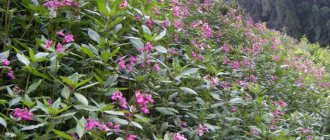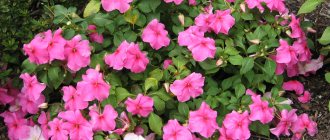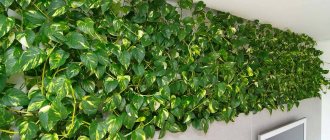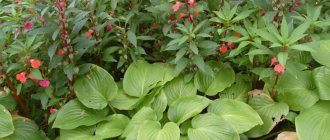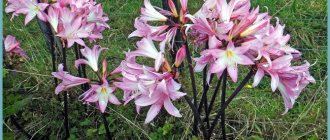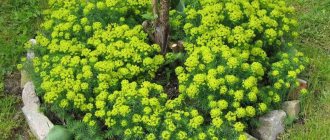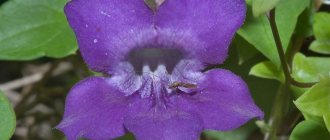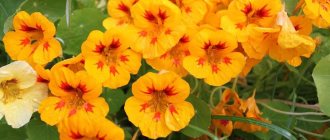Impatiens is a very popular flower due to its beauty and unpretentiousness.
Impatiens is one of the oldest inhabitants of gardens and apartments, which does not lose its popularity even today. It is enough to go to any forum of flower growers and gardeners, where you can always find many photos and discussions, the hero of which is Vanka wet. This is the second common name of the flower in our country, due to the fact that after watering small droplets form on the leaves. But the British call it “zealous Lisa” for its long flowering.
Description of Impatiens or Impatiens
The plant consists of one- and two-year-old flowers and shrubs, reaching from 20 to 1 m in height. Shiny fleshy leaves with sharp toothed edges, shaped like an oval. There are about 500 species in nature, and breeders have developed the most resistant varieties to our climatic conditions, resistant to pests and diseases.
Hybrids have both simple and velvety flowers of purple-pink colors. Spurs form in the opened inflorescences, touching which after ripening causes a sharp eruption of seeds.
Currently, more than a thousand hybrid species of Impatiens are known; they are grouped into two main categories.
- Common Impatiens walleriana is one of the most common plants used to decorate public parks and gardens around the world. This herbaceous perennial plant is considered an annual in frost-free climates. Standard Impatiens are available in a variety of colors, grow best in full or partial shade and can reach up to 60cm in height depending on the variety.
- New Guinea balsam (Impatiens hawker)—also popular because of its higher sunlight tolerance—is a hybrid variety that produces larger, brighter colors than standard Impatiens. New Guinea balsam is mildew resistant and can grow up to 1m tall, with foliage in a variety of colors including green, purple and bronze. It is generally more difficult to grow from seed.
Why does the plant dry out and turn yellow?
Yellowing of leaves is an alarming signal of trouble: it is urgent to find out and eliminate the cause of this phenomenon.
It could be:
- excess sunlight, which caused burns of the leaves;
- moisture deficiency;
- temperature too low.
Rules for planting and caring for Ogonyok in open ground
Garden Balsam loves natural light, the lack of which affects its flowering and growth. You can get a long stem devoid of buds. Therefore, they mainly choose western and eastern directions on the site to create flower gardens with this plant. But in intense summer heat, you should consider the possibility of shading, otherwise the Impatiens will simply burn.
Growing garden balsam seedlings from seeds
It is recommended to sow garden balsam seeds in the ground in March, but it is possible in early April, it depends on the climatic conditions of the region. With earlier sowing, crops will need to be supplemented with light, which is not always possible.
In order for Ogonyok to develop comfortably, wide containers with drainage holes are selected for sowing. The optimal solution is cassettes, which are used for planting different crops. A layer of expanded clay must be placed on the bottom of the pot, after which soil is placed. The soil chosen is loose, based on peat, sand, perlite in equal proportions. A prerequisite is to treat the mixture with a fungicidal preparation to eliminate the possibility of fungi.
Seeds also require additional processing before sowing. They are dipped in potassium permanganate, kept there for 20 minutes, after which they are soaked in a preparation that stimulates crop growth. Then the seed is washed and dried on a napkin.
When the seeds are distributed in the container, they need to be sprinkled with soil or buried slightly, but not more than 5 mm. The optimal distance between seeds is up to 3 cm. To make planting convenient, you can use a moistened toothpick. After sowing, the soil must be sprayed with water from a spray bottle, and the container is covered with film or glass. The container with plantings can be placed on the windowsill, but provided that it is not exposed to direct ultraviolet rays.
You can observe the first shoots after one and a half to two weeks. Sometimes it happens earlier. It is important that the daylight hours are about 12 hours, and that the seedlings themselves receive good air ventilation.
Crops should be watered in a tray to avoid excess water. When up to 7 leaves are formed on the plants, they can be planted in separate pots. Before transferring balsam to the garden, be sure to harden it.
You might be interested
Decorative liana Ipomoea: cultivation and use in garden design
Red perennials: the best plants to grow in the garden
Perennial shade-loving flowers and plants for the garden: a selection of the best plants
Planting Balsam seedlings in open ground
Ogonyok is planted in a pre-prepared hole, fertilized with peat, humus and drained with sand. Transferring from the pot is done very carefully, as the plant can easily break. After filling with soil, the root system is watered and drainage is arranged. Impatiens love water, but its stagnation is just as dangerous for them as lack of watering. Irrigation every 2-3 days during periods when the sun does not dry out the surface of the earth very quickly will be sufficient.
Rooted bushes can be pinched to obtain a more bushy version of the plant. Nitrogen-potassium fertilizing of soil for balsam guarantees gorgeous flowering throughout the season. If a row of impatiens is to be planted, an interval of 30 cm is maintained so that the root system does not grow together.
Is it necessary to replant the plant?
Indoor perennial varieties of impatiens need replanting.
The procedure is performed:
- 2 weeks after purchasing a new plant;
- when the pot becomes too small for the root system, as evidenced by roots peeking out of the drainage hole, limp, curled leaves;
- every spring, because over the course of the year the soil becomes depleted and requires replacement.
Annual transplants:
- have a rejuvenating effect on the plant;
- stimulate more intensive growth and flowering;
- facilitate the flow of air and water to the root system.
Preparing the soil for replanting
The main requirements for the soil into which balsam is supposed to be transplanted are nutritional value and air saturation (looseness).
You can purchase a ready-made store-bought substrate or make it yourself by combining in equal parts:
- leaf humus;
- turf soil;
- peat;
- sand.
You can also add charcoal and dolomite flour to the mixture for disinfection.
Step-by-step instructions for transplantation
An illiterate transplant can be fatal for balsam, so the following rules must be strictly followed:
- Choose a pot that matches the size of the root system. Usually a container is taken whose diameter is 1-1.5 cm larger than the diameter of the old dishes. Approximately ¼ of the pot should be occupied by a drainage layer. A large pot volume will require too much effort from the root system to develop a new territory, and the balsam will not bloom.
- The day before planting, water the plant generously. This will help keep the earthen ball intact and perform procedures with the least risk of injury to the roots.
- Carefully use a knife to walk along the inner walls of the pot, separating the soil from them.
- Remove the top layer of soil to expose the plant stem.
- Lightly pulling the stem, remove the balsam from the pot along with the earthen lump. If necessary, you can push it with a wooden stick through the drainage hole.
- Place the plant in the center of the new pot.
- Fill the voids with soil, lightly pressing it down.
- Place soil on top, leaving the root collar open.
- Water the transplanted balsam and place it in a shaded place.
- After 3 weeks, fertilize.
During flowering, the plant cannot be replanted: existing flowers will fall off and new ones will no longer appear.
How to care for garden balsam in the garden
When choosing a place for planting and further care, you need to take into account which group of balsams your flower belongs to.
What kind of soil does a flower need?
Grow garden impatiens in fertile, well-drained soil. It needs a lot of water, so it is important that your soil provides adequate drainage. If you are planting in a container such as a window box or hanging basket, use well-drained soil.
Enrich the soil with nutrients. Before planting, fertilize the soil with aged compost. This organic food will provide your Impatiens with the extra nutrients they need to thrive.
Lighting
Choose a shady place for the plant, protected from the wind. Common Impatiens are one of the few flowering plants that grow best in shade, while New Guinea Impatiens typically do best in partial sun.
Watering Impatiens
Water the plants regularly to keep the soil moist. About 2 inches of water per week is the optimal amount of moisture, but be careful not to overwater. Applying a layer of organic mulch can help the soil retain moisture and prevent leaves from wilting in hot weather. If you have planted your seedlings in a pot, they will generally need more water than if they were planted in the ground.
Fertilizer
Fertilize garden balsam regularly throughout the growing season. Regular fertilizing promotes healthier flowering of Impatiens flowers. Use water-soluble fertilizer every two weeks as directed. If you used a slow-release fertilizer at planting time, you can apply the same fertilizer again in midsummer.
Collecting Ogonyok seeds
To collect your own Impatiens seeds, you don't have to do anything very complicated. It is enough to take a bag or box and bring it to the achene, and then touch it.
The second option is to collect seeds along with the boxes. This is done early in the morning, but this procedure requires more dexterity. The bolls should be gently squeezed with your fingers, the stalks should be torn off, and the achenes should be rubbed between your fingers. The contents must be dried on a plate, after which they are placed in paper bags. Proper storage guarantees excellent seed germination - up to 8 years.
Pest and disease control
Impatiens (growing and caring for the plant require a competent approach) will not please their owners if the rules for their cultivation are violated.
In this case, the following problems are possible:
- root rotting , in which the plant gradually dries out and dies. Drying the soil and treating it with Trichodermin or Fitosporin and temporarily reducing the volume of watering will help prevent such an outcome;
- bacteriosis , manifested by black spots on the leaves, affects plants forced to remain for a long time at temperatures below 15 ° C. Alerin is used for treatment;
- pests: spider mites, aphids, whiteflies. For minor symptoms, you can wipe the leaves with a soap solution for treatment. If time is lost, insecticides will come to the rescue: Actellik and Fitoverm.
Problems in caring for the Ogonek flower in the garden
Caring for Balsam is not a very labor-intensive process. But it is necessary to replant perennial lights at least once a year and carefully check the foliage for diseases. From time to time, inspect the plant for spider mites, which are often found in these flowers. To combat the pest, use a solution based on laundry soap; if the folk remedy does not help, then you will have to resort to insecticides. Also, sometimes crops can be affected by aphids. To get rid of the insect, tobacco dust is best suited, which is sprinkled on the soil and the plant itself. When attacked by whiteflies, it is best to resort to sticky traps.
Is it necessary to prune the plant?
Pruning is necessary for heavily overgrown balsam bushes. It is performed in early spring, the branches are cut to half their length. If the flower shape is compact, then only its top is cut off to form a more lush bush.
As necessary, sanitary pruning is performed, during which the following is removed:
- wilted flowers;
- yellowed leaves;
- broken branches;
- weak shoots.
In addition, stems that create excessive thickening or grow inside the bush must be removed.
Garden Balsam in landscape design
Garden Light can be used in garden decoration for various functional and aesthetic purposes due to the presence of many varieties of this plant. They will decorate borders and paths, create a beautiful background or add a bright accent to the heart of the entire composition.
They are planted in pots in small garden areas for vertical gardening. The exterior of buildings is also decorated in this way. Container Balsams will become bright lights near recreation areas and in courtyard areas. Verbena, Fuchsia, Begonia will be excellent “neighbors”.
If you use group planting, you can get a whole field of incredibly luxurious flowers. The use of balsams of various shades will give the garden an enchanting sound. This plant allows you to realize the full creative potential of the owner of the site and is guaranteed to get a positive result from your work.
Flower Vanka wet correct name
They came up with so many names for flowers from the genus Balsamaceae, “Ogonyok”, and “Touch-me-not”, but the most popular and memorable one turned out to be “Vanka wet”. Why "Vanka"? And why “wet”? The fact is that when there is an abundance of moisture, during a thunderstorm or rain, this flower releases its own moisture from its leaves, scientifically called guttation. And he was nicknamed “Vanka” because this flower has long been a favorite of flower growers’ window sills.
In literally every village, in every village, this fragrant plant blooms in a pot or cut-off plastic bottle. From here it received the simple nickname Vanka, which is found in every village. The correct and full name of the plant is Impatiens balsamina or Impatient balsam, which, in principle, corresponds to its biology. As soon as Balsam feels the cold, it stops blooming. With a careless touch, he can even throw off the flowers.
Popular types of Impatiens for the garden
This plant can be divided into two large groups: garden and indoor balsams. They have common features and growing requirements, but domestic species are less resistant to weather changes. Let us describe popular garden species.
Tom Thumb (Impatiens Tom Thumb)
Tom Thumb (Impatiens Tom Thumb)
A spreading balsam a quarter of a meter in height. Pleasant to the touch, lanceolate-serrate foliage frames velvety buds, which can be soft white, bloody, lilac, or pinkish in color.
Balsam Camellia (Impatiens Camellia)
It grows in the shape of a pyramid, formed from fleshy foliage and large 4 cm buds of milky, lilac shades or a compilation of them.
Waller's Impatiens (Impatiens walleriana)
The name unites several subspecies, differing in flower texture (simple or double), color scheme (all shades of red), petals (plain or with pale stripes).
Waller's Impatiens (Impatiens walleriana)
Their advantage is the shape of the bush - it is ideal for a gardener who is fond of topiary, as it often represents an almost perfect circle. Flowering occurs profusely during the warm period of the year.
Balsam Exotic (Impatiens Exotic)
A bush up to 15-20 cm with serrated-lanceolate leaves and burning buds of deep pink, soft lilac, lilac and all their various variations.
Garden balsam variety Carmelita
This is an annual crop that grows up to 0.7 meters. The flower is thermophilic, shade-tolerant, and moisture-loving. It is distinguished by large inflorescences of different colors. Flowering is observed from June to September.
New Guinea balsam (Impatiens hawker)
This group of hybrids is large in size, but there are small flowers. The height reaches up to 1 m cm. The leaves have a wide range of colors - from bronze to dark green, with a yellow center. The stem is usually reddish in color.
New Guinea balsam
This ornamental plant is presented in a variety of species, which will satisfy the aesthetic needs of the most demanding gardener. Lately, hanging balsam has become quite common. Among indoor balsams, we can distinguish varieties of terry balsam, popular among gardeners, such as Athena, Salsa Red White and others.
Fertilizers for plants
It is recommended to feed a healthy, normally developing plant only before the appearance of buds and during the period of active flowering. Fertilizing is carried out once every 14 days, and the concentration of the solutions should be half as much as indicated on the packaging. If there is excess nutrition, balsam will not bloom.
Mineral mixtures
Compositions containing nitrogen are used - in the period preceding flowering, and phosphorus-potassium mixtures - with the appearance of the first buds and during intensive flowering.
Organic fertilizers
Most varieties of balsam do not like fertilizing with organic matter. For example, an attempt to fertilize a flower garden with manure will lead to shedding of buds and wilting of foliage. In autumn, balsams are not fertilized on the site. In addition, you should not feed sick, weakened or recently transplanted plants.
How to grow from seeds
To obtain sprouts by sowing seeds, you must:
- collect flower soil in a plastic container, mixing it with vermiculite or sand;
- compact a little and spray the contents from a spray bottle;
- distribute small seeds evenly over the damp surface;
- and just lightly sprinkle with soil.
To wait for the sprouts to germinate, the container must be placed in a plastic bag to create a small greenhouse. Place in a warm, bright place, out of direct sunlight. Germination occurs at 21 C after 15 days.
Advice. Ventilate the crops daily and keep the earthen ball moist.
After germination, the shelter can be removed. When two true leaves appear, the seedlings are plucked - carefully transplanted into small 50-60 ml cups filled with soil substrate.
Growing from seeds allows you to have the largest amount of planting material.
Reproduction methods
The flower can be propagated by seed and vegetative methods. They are both equally effective.
Seeds . The best time to plant seeds is spring. It is better to pre-soak the seeds overnight. In the morning they are dried a little and planted in a mixture of sand and peat. Containers with planted seeds must be covered with film and maintained at a stable temperature in the range of 18-20 degrees. After germination, the seedlings are planted, that is, planted in different pots. When the plant has grown, it must be pinched to activate the growth of new leaves.
To grow a young plant, you can take cuttings from the top of an old one. The optimal length is 5-6 cm. Next, the cuttings are placed in water for rooting. To speed up the process, it is better to add Kornevin to the water. After roots have formed, the plants are planted in pots and pinched to stimulate the formation of new branches.
